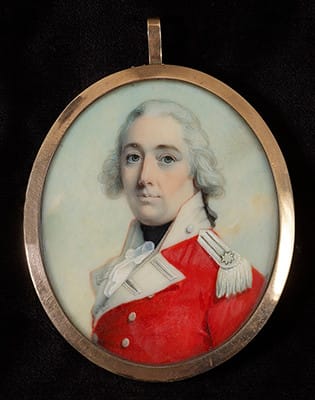
John Donaldson
Portrait miniature of an Officer in Red, late 18th century
Watercolour on ivory
Oval, 2 ¼ inches, 5.7cm high
Philip Mould & Co.
To view all current artworks for sale visit philipmould.com At the age of just twelve John Donaldson had gained a reputation as a competent artist, working in Indian inks and...
To view all current artworks for sale visit philipmould.com
At the age of just twelve John Donaldson had gained a reputation as a competent artist, working in Indian inks and producing portraits as well as copies of the Old Masters. Donaldson’s talents were able to support not just himself but his family too, his father, a glover, obviously falling on hard times. After spending several years working in Edinburgh Donaldson moved to London where he established himself as a portrait miniature painter with immediate success, exhibiting with the Society of Artists in 1761 and winning a prize in 1764, presumably for an historical drawing The Tent of Darius we find mentioned in numerous primary sources. Donaldson also worked in enamel during this period and two known works include; The Death of Dido and another from the story of Hero and Leander, both of which received prizes from the Society of Artists. Donaldson’s clientele were quite distinguished; the Earl of Buchan for example, who co-published Donaldson’s memoirs after his death, held numerous works (possibly including the works mentioned above) in his collection.
After a while however, Donaldson’s interests as an artist waned and his attentions shifted to more philosophical affairs, including views on the health and correction of mankind’s morals, so much so in fact that one contemporary writer recalls how; ‘I remember the late Lord North’s carriage going from the painter’s door with a ‘not at home’ because Mr D. was not at that moment in a humour to paint.’ Donaldson was prodigious, however, in other respects, publishing ‘Essay on the Elements of Beauty’ (1780) and a collection of poems (1786) as well as patenting a method of keeping vegetables and meat preserved long-distant voyages. Donaldson exhibited his last work at the Royal Academy in 1791, with failing eyesight and weakening health Donaldson was moved by friends to lodgings in Islington where he died in October 1801.
The present work must date to the late 1780s for a few reasons; firstly, sky backgrounds, as seen here, were not introduced by Richard Cosway until c.1785, and secondly, the way Donaldson has left large areas of un-hatched ivory is typical of the artist in his maturity, suggested again by strong, confident shadowing in the sitter’s face.
A touching family sentiment can be seen on the reverse of this miniature, where we see six strands of plaited hair, belonging, presumably, to the sitter’s six children, with his wife’s hair found in a locket in the centre.
At the age of just twelve John Donaldson had gained a reputation as a competent artist, working in Indian inks and producing portraits as well as copies of the Old Masters. Donaldson’s talents were able to support not just himself but his family too, his father, a glover, obviously falling on hard times. After spending several years working in Edinburgh Donaldson moved to London where he established himself as a portrait miniature painter with immediate success, exhibiting with the Society of Artists in 1761 and winning a prize in 1764, presumably for an historical drawing The Tent of Darius we find mentioned in numerous primary sources. Donaldson also worked in enamel during this period and two known works include; The Death of Dido and another from the story of Hero and Leander, both of which received prizes from the Society of Artists. Donaldson’s clientele were quite distinguished; the Earl of Buchan for example, who co-published Donaldson’s memoirs after his death, held numerous works (possibly including the works mentioned above) in his collection.
After a while however, Donaldson’s interests as an artist waned and his attentions shifted to more philosophical affairs, including views on the health and correction of mankind’s morals, so much so in fact that one contemporary writer recalls how; ‘I remember the late Lord North’s carriage going from the painter’s door with a ‘not at home’ because Mr D. was not at that moment in a humour to paint.’ Donaldson was prodigious, however, in other respects, publishing ‘Essay on the Elements of Beauty’ (1780) and a collection of poems (1786) as well as patenting a method of keeping vegetables and meat preserved long-distant voyages. Donaldson exhibited his last work at the Royal Academy in 1791, with failing eyesight and weakening health Donaldson was moved by friends to lodgings in Islington where he died in October 1801.
The present work must date to the late 1780s for a few reasons; firstly, sky backgrounds, as seen here, were not introduced by Richard Cosway until c.1785, and secondly, the way Donaldson has left large areas of un-hatched ivory is typical of the artist in his maturity, suggested again by strong, confident shadowing in the sitter’s face.
A touching family sentiment can be seen on the reverse of this miniature, where we see six strands of plaited hair, belonging, presumably, to the sitter’s six children, with his wife’s hair found in a locket in the centre.
Be the first to hear about our available artworks
* denotes required fields
We will process the personal data you have supplied in accordance with our privacy policy (available on request). You can unsubscribe or change your preferences at any time by clicking the link in our emails.